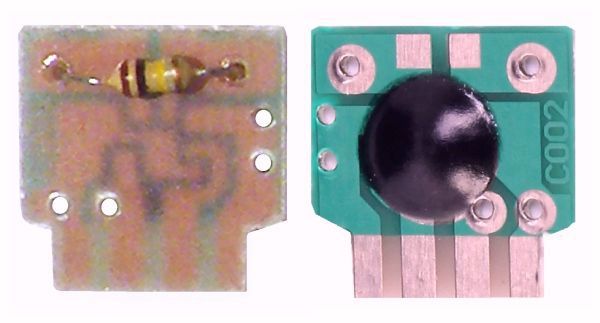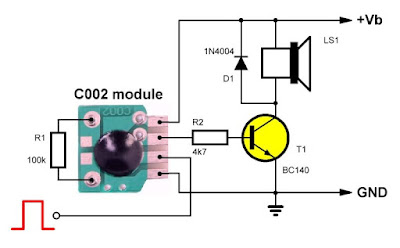
|
For less than ten eurocents you can buy this micro module that generates the familiar sound of an alarm siren, the sound you hear when a car alarm or a PIR detector goes off. |
Introduction
The C002 module is only a sound generator and does not provide a signal that powers a loudspeaker directly. You must connect an extra amplifier stage to the output of the module. The only extra part you need on the module itself is a 1/8 W or SMD resistor of 100 kΩ.
The C002 module is really very small, it fits easily on the nail of your little finger. The circuit board is 12 mm wide and 11 mm high. On the narrow underside there are four small copper soldering pads to connect the module. At the top there are two soldering pads on which you can solder the SMD resistor mentioned above. On the left and right there are two pads with holes, in which you can solder a 1/8 W resistor if you can't handle SMD parts.
 |
| The extremely small C002 module. (© 2020 Jos Verstraten) |
Technical data
Few technical details of this module are known:
- Target price: US$ 0.05 ~ US$ 0.10 each
- Supply voltage: 2.4 Vdc ~ 3.6 Vdc
- Operating current: 150 μA max.
- Quiescent current: 5 μA max.
- Output current: 3.0 mA max.
- Oscillator frequency: 80 kHz ~ 120 kHz
- Working temperature: 0 °C ~ 60 °C

The front and back of the module
The photo below shows the two sides of the module. Please note that the soldered resistor of 100 kΩ is not present at the time of purchase!
 |
| Both sides of the C002 module. (© 2020 Jos Verstraten) |
Connection data
The figure below summarises the connection data of the C002 module:
- +Vb:
Positive supply voltage, 3.6 V max. - OUTPUT:
Output with squarewave signal switching between ground and +Vb. - ENABLE:
The circuit oscillates when this pin is open or connected to +Vb. The output goes to GND when this input is connected to ground. - GND:
Ground. - Rx:
Between these two connections there is a resistor of 100 kΩ to 240 kΩ which determines the frequency of the output signal. With 100 kΩ, the output frequency sweeps around 2.8 kHz.
 |
| The connections of the C002 module. (© 2020 Jos Verstraten) |
CAUTION!
The terminals OFF and ENABLE have been swapped on various pictures on the Internet. We have tested the module and our drawing is really the only correct one!

The output signal
The C002 module provides a squarewave signal switching between ground and +Vb whose frequency is quickly swept back and forth. This creates the typical alarm sound. With a resistance of 100 kΩ, the output frequency sweeps around 2.8 kHz. The oscillogram below shows a snapshot of the output signal. Because of the fast frequency modulation, all output frequencies are written on top of each other. The green arrows indicate the sweep range, i.e. the difference between the minimum and maximum period of the signal.
 |
| The output signal of the C002 module. (© 2020 Jos Verstraten) |
Example circuits
In the figure below, the C002 module is used to power a low-ohmic loudspeaker. The output signal of the module drives an ordinary bipolar transistor to cutoff and saturation. The loudspeaker LS1 is the load of the transistor. The diode D1 is necessary to short-circuit the large voltage peaks that can occur over the coil of the loudspeaker when driving the transistor to cutoff.
 |
| Powering a loudspeaker with the C002 module. (© 2020 Jos Verstraten) |
In the figure below, the module is used to power a piezo-ceramic transducer Tr1. Because such a component requires much more voltage than the available supply voltage of 3.6 V, you have to work with a tapped inductor L1. You wind this coil on a ferrite core. The upper winding should have a resistance of approximately 15 Ω, the lower winding approximately 150 Ω. This will boost the voltage across the transducer to 35 V, good enough to produce a lot of sound in the transducer.
 |
| Powering a piezo-ceramic transducer from the C002 module. (© 2020 Jos Verstraten) |

USB Logic Analyzer 24M 8CH
